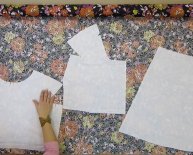
Bengaline fabric characteristics
A sturdy warp-faced fabric with pronounced crosswise ribs formed by bulky, coarse, plied yarns or rubber thread. Filling is not discernible on back or face of goods. Originating in Bengal, India, it is used mainly in coatings, mourning ensembles, and women's headwear. When cut to ribbon widths, it is called grosgrain.
A durable plain weave fabric characterized by widthwise cords formed by using fine warp yarns and course weft yarns, Used in dresses, coats, suits, ribbons, draperies.
A fabric with a crosswise rib and warp faced made from silk, wool, rayon, synthetics and cotton, often in combination. Bengaline was first made of silk in Bengal, India. Ribs are round and raised. Often has wool or cotton dilling in the ribs which doesn't show. It is difficult to make bound buttonholes in it. Has a tendency to slip at the seams if too tightly fitted. Grosgrain and Petersham is bengaline cut to ribbon widths.
A sturdy warp-faced fabric with pronounced crosswise ribs formed by bulky, coarse, plied yarns or rubber thread. Filling is not discernible on back or face of goods. Originating in Bengal, India it is used mainly in coatings, swimsuits, mourning ensembles, and womens headwear. When cut to ribbon widths is called grosgrain.
A firm light-weight material having a silk warp and woolen filling giving a ribbed effect.
A fine rib effect in worsted blend fabrics for slacks and suits. Durable and decorative with interesting texture Originally from Bengal, India.
A fabric with a crosswise rib made from textile fibers (as rayon, nylon, cotton, or wool) often in combination.
Fibre: Silk, wool, rayon, synthetics, cotton. Weave: Crosswise rib, warp faced. Characteristics: First made of silk in Bengal, India. Ribs are round and raised. Often has wool or cotton dilling in the ribs which doesn't show. Difficult to make bound buttonholes in it.

















